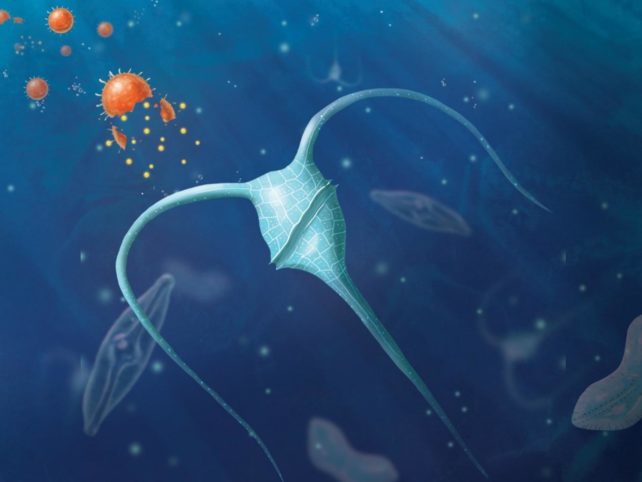Our failure to decisively mitigate climate change is prompting researchers to examine more drastic approaches, like fertilizing the oceans to combat the massive excess of carbon dioxide in our air.
“At this point, time is of the essence,” says Michael Hochella, an Earth scientist at the US Department of Energy’s Pacific Northwest National Laboratory.
“To combat rising temperatures, we must decrease CO2 levels on a global scale. Examining all our options, including using the oceans as a CO2 sink, gives us the best chance of cooling the planet.”
Phytoplankton, the photosynthesizing variety of microorganisms that float on the ocean’s surface, are one of the main components of the carbon cycle’s biological pump that takes CO2 out of the air to store in the ocean’s depths.
The tiny organisms need minerals like iron to grow and multiply, but there’s only a fixed amount floating at the surface of the waters with them, which limits how much phytoplankton can bloom.

So just as fertilizer can help photosynthesizing organisms flourish on land, the same help could – theoretically – be offered to the sunlight eaters that float on our seas.
Whales once performed a huge chunk of natural ocean fertilization, feeding plankton the otherwise out-of-reach nutrients via giant plumes of poop. Before industrial whaling drastically diminished whale numbers, whales helped remove close to 2 million tonnes of carbon dioxide a year through this process; now it’s closer to 200,000 tonnes.
So by artificially adding this missing fertilizer, we could stimulate these microbes to grow and reproduce, suck up more CO2 from the air, and carry it with them to their deaths. The CO2 is stored in the ocean floor at this point, back to where most of the excess has been released thanks to human activities.
This poetic completion of the cycle we’ve broken could sequester this carbon for hundreds of thousands of years, as the fossils-turned-fuel did before them.
Larger soluble forms of the required nutrients don’t tend to linger near the surface for long enough to be used up by the phytoplankton, the team explains, so researchers turned to nanoparticles. Nanoparticles like iron oxides and iron oxyhydroxides are natural ocean fertilizers from sources like volcanic ash and soil sediments.
“The idea is to augment existing processes,” says Hochella. “Humans have fertilized the land to grow crops for centuries. We can learn to fertilize the oceans responsibly.”
Reviewing 123 studies, University of Leeds biogeochemist Peyman Babakhani and colleagues found some engineered nanoparticles that might be candidates for safely fertilizing phytoplankton growth.
Artificial ocean fertilization would need to happen at a level that increased the microalgae numbers but not enough to risk toxicity.
Some of the studies the team assessed were able to achieve an increase of 35-756 percent algal growth and abundance compared with controls.
What’s more, it appears that the nanoparticle’s affinity to the cell surfaces (in this case, phytoplankton) dictates how much is taken up, rather than concentrations, so it could be released at levels equivalent to those already in the seawater.
Some experiments found that the growth of phytoplankton blooms using ocean fertilizer ended up depleting other surrounding nutrients that weren’t artificially supplied. This stalled their growth, which means future fertilizers might need to incorporate more minerals.
“If considerable CO2 drawdown is achieved by using engineered nanoparticles, this may allow applications of the approach as a carbon dioxide removal technology at smaller scales or specific locations,” the team explains in their paper, “and thus allay some of the concerns regarding risks of geoengineering the entire marine ecosystem and downstream ‘nutrient stealing’.”
As with any wide-scale manipulations of the environment, this proposal does not come without significant risks, much like the use of land fertilizers.
“While natural nanoparticles exist in most ocean settings, the potential adverse environmental risks of adding [engineered nanoparticles] to the ocean require rigorous assessment,” Babakhani and colleagues warn.
None of these particles have undergone a focused study in realistic conditions, so this idea is very much still in the brainstorming stage.
The long-term impact of the nanoparticles on the biogeochemistry of the oceans is unknown, especially in light of their tendency to aggregate over time in marine ecosystems, potentially smothering life below the ocean’s surface.
The researchers outline a plan to begin addressing the numerous concerns. But they estimate that although engineering the correct nanoparticles would be substantially more expensive than using existing materials, it would give us the ability to tailor them to the needs of specific environments (those that need more silicon or iron, for example), making them more effective.
While the need for such extreme interventions is becoming more and more likely, researchers acknowledge they must be approached with extreme caution. Meanwhile, we already have reliable and much better understood methods of geoengineering: protecting remaining and restoring lost and degraded ecosystems.
This research was published in Nature Nanotechnology.



